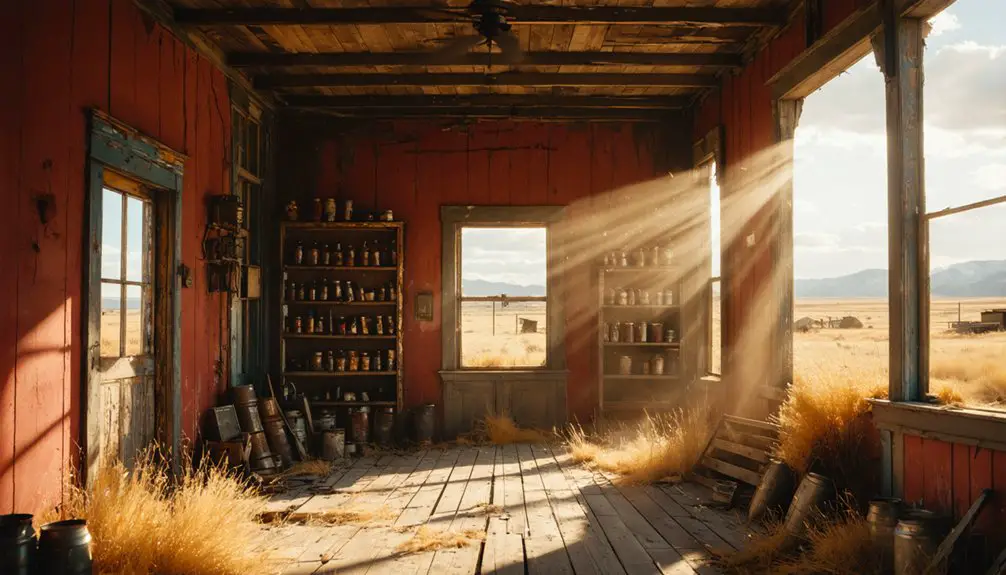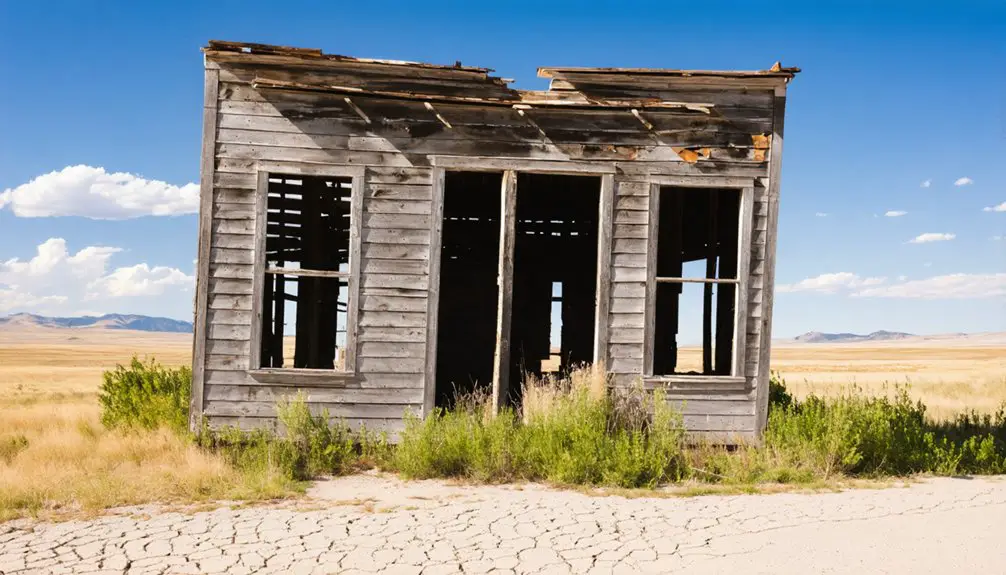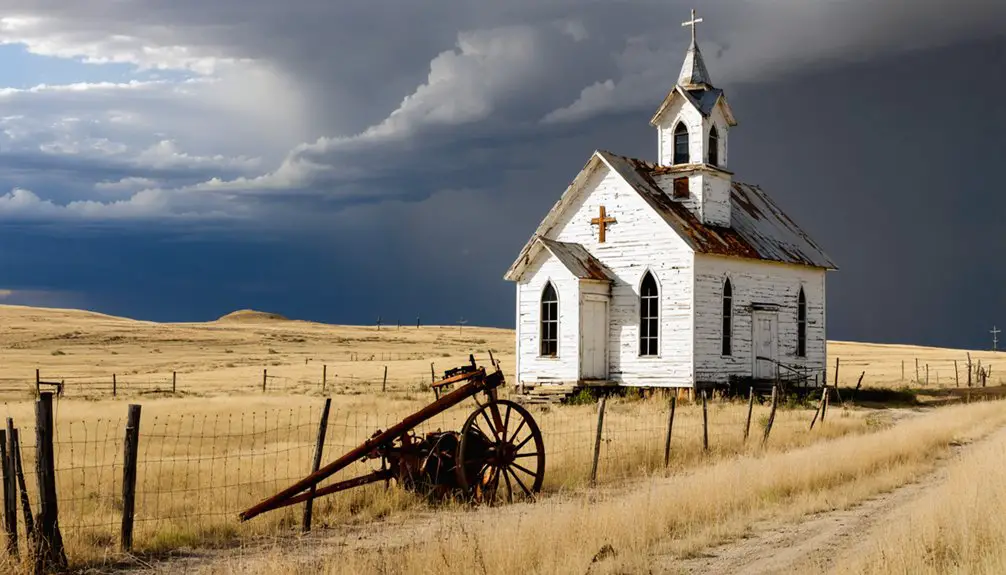You’ll find Bosler, Wyoming’s haunting remnants along Highway 30 in Albany County, where this once-thriving railroad town has faded into ghost town status. Founded in 1909 as a cattle shipping hub by the Union Pacific Railroad, Bosler grew to 264 residents before Interstate 80’s opening in 1970 sealed its fate. Today, only 10-15 residents remain among the weathered buildings, while Doc’s store stands as the sole business, holding stories of frontier resilience and dramatic change.
Key Takeaways
- Bosler, Wyoming declined from a thriving railroad town of 264 residents to a ghost town after Interstate 80 bypassed it in 1970.
- Only 10-15 residents remain in Bosler today, with Doc’s furniture store being the last operating business in town.
- The town’s abandoned buildings, including a fallen schoolhouse and defunct post office, stand as remnants of its prosperous past.
- Established in 1909 along the Union Pacific Railroad, Bosler flourished as a cattle shipping hub and Highway 30 service stop.
- Harsh climate conditions, with extreme temperature swings and limited rainfall, contributed to the town’s eventual abandonment.
The Birth of a Railroad Town
As the Union Pacific Railroad expanded across Wyoming in the early 1900s, the town of Bosler emerged as a strategic rail stop in 1909.
You’ll find its railroad significance deeply rooted in the vision of Frank Bosler, owner of the Diamond Ranch, who recognized the potential of establishing a shipping hub for regional cattle operations.
The community development centered around the railroad tracks, with the townsite strategically positioned to maximize access to the transcontinental line.
While the nearby Wyoming Station had previously served as an unremarkable loading point, Bosler’s establishment marked a more purposeful approach to meeting the area’s transportation needs.
The Bosler family’s extensive ranching interests and business acumen helped transform this rail stop into a proper town, complete with a post office by 1908.
Located 19 miles north of Laramie, the town offered an ideal location for ranchers to transport their cattle by rail.
The town was named after James Williamson Bosler, a prominent cattle baron who influenced the area’s early development.
Life on the High Plains
You’d need remarkable fortitude to withstand Bosler’s punishing climate, where temperatures could swing 100°F in 24 hours and bitter westerly winds amplified winter’s bite.
Your ranch work would revolve around protecting livestock from these harsh elements while racing against a brief 125-day growing season that often saw frost in both late spring and early fall.
Like much of the state’s eastern region, the area typically received 10-12 inches of annual precipitation, making every drop of moisture precious for survival. You’d constantly adapt your agricultural schedule to the High Plains’ temperamental weather patterns, timing livestock movements and crop plantings around the region’s notorious wind storms and sudden temperature shifts. Most families supplemented their income through dryland farming or irrigation, drawing from the vast Ogallala Aquifer to sustain their crops.
Harsh Weather Endurance
Life on Wyoming’s high plains demanded exceptional resilience from Bosler’s inhabitants, who faced dramatic temperature swings between scorching days and frigid nights. You’d need to master essential weather adaptations just to make it through the seasons, from layering clothes to constructing wind-resistant shelters that could withstand brutal winter storms.
Your survival strategies had to account for the region’s meager rainfall – less than 20 inches annually – and persistent winds that could transform a cold day into a dangerous situation through wind chill. Modern weather data shows wind speeds reach 19 mph during evening hours. You’d store water carefully and develop food preservation techniques for the long winters. Barometric pressure readings help residents anticipate incoming weather changes.
When blizzards struck, you’d rely on community preparedness and cooperation. Living in Bosler meant adapting to nature’s extremes, where temperatures could plummet below freezing and summer days rarely exceeded the upper 70s.
Ranch Life Challenges
While ranching near Bosler offered opportunities for enterprising settlers, the harsh realities of high plains life brought constant challenges that would test even the most resilient ranchers.
You’d face cattle rustling that threatened your livelihood, forcing ranches like Diamond to hire gunmen for protection. The isolation and vast distances between properties made enforcement difficult, leading to violent confrontations and deep-seated community distrust. Settlers received anonymous warnings before violence erupted, creating an atmosphere of fear. After Tom Horn’s execution in 1903, ranchers had to find new ways to protect their cattle investments.
- You couldn’t rely solely on ranching – successful operations required diversification into shipping, real estate, and local commerce.
- Ranch disputes between partners often erupted over financial matters and legal defense costs.
- You’d struggle with marketing challenges as development companies oversold the land’s agricultural potential.
- Your ranch served as both an economic venture and an essential social hub for workers in the sparsely populated region.
Seasonal Agricultural Patterns
Agricultural success on the high plains near Bosler demanded precise timing and adaptation to the region’s short growing seasons. At 7,000 feet elevation, you’d need to carefully plan your crop rotation between hardy winter wheat, which could survive the cold months, and spring plantings of barley or cool-season vegetables. The success of these agricultural ventures was overseen by Iron Mountain Ranch, which operated extensive farming operations in the area.
You’d start planting in late April or early May once frost risks diminished, bringing in seasonal labor for the busy periods. The harvest would keep you working from late July through September, depending on weather patterns and elevation. The Farmers Trust Company helped local growers finance their seasonal operations between 1911 and 1919.
If you were farming in the early 1900s, you’d rely heavily on irrigation projects like those from the Rock Creek Conservation Company to extend your growing season. Rail transport was vital – you’d time your harvest to match shipping schedules for getting crops to market.
Boom Years and Economic Growth
As Bosler emerged from its railroad origins in 1908, the town’s strategic location and transportation connections fueled its initial growth phase.
Economic opportunities flourished as both the railroad and Highway 30 brought steady streams of travelers and commerce through the settlement. By the 1940s, you’d find a bustling community of 264 residents enjoying modest but sustainable community growth.
- The Diamond Ranch’s shipping operations anchored the town’s early economic foundation
- Highway 30’s completion in 1912 transformed Bosler into a crucial roadside service hub
- Local businesses thrived by serving both area ranchers and cross-country travelers
- The town’s strategic position near major highway junctions (US 30/287 and SH 34) maximized commercial potential
This golden era of prosperity would continue until Interstate 80’s arrival changed everything in 1970.
A Town’s Heartbeat Fades

Before Interstate 80 opened on October 4, 1970, you’d find Bosler thriving as a crucial stop along Highway 30, where its bar and local businesses served countless travelers.
You could witness the town’s commerce gradually waning as traffic patterns shifted westward toward Laramie’s new interstate corridor, leaving Bosler’s service-based economy starved of its customer base.
If you’d visited the town’s last remaining business—its bar—you would have seen desperate attempts by entrepreneurs to draw customers back, but these efforts couldn’t overcome the devastating impact of the new transportation routes.
Life Before Interstate 80
During the early to mid-1900s, Bosler’s lifeblood flowed through two essential arteries: the Union Pacific railroad tracks and the Lincoln Highway.
You’d find a bustling community development shaped by the transportation evolution, where cattle operations and railroad commerce defined daily life at 7,000 feet elevation.
When the Lincoln Highway rerouted east of the tracks in 1925, the town’s heart shifted with it, as businesses followed the traffic flow.
The local economy thrived on these key elements:
- Large-scale cattle ranching operations run by influential families like the Boslers
- Agricultural projects promoting farming despite challenging high-altitude conditions
- Railroad shipping services for livestock and lumber at Bosler and nearby Tie Siding
- Highway traffic that sustained local businesses until Interstate 80’s arrival
When Commerce Disappeared
While the Lincoln Highway and Union Pacific Railroad once brought prosperity to Bosler, the town’s commercial pulse began to weaken in the mid-20th century.
You’d have seen the economic shift unfold as transportation patterns shifted dramatically. When Interstate 80 opened in 1970, it bypassed Bosler completely, dealing a fatal blow to businesses that relied on passing travelers.
The commercial decline hit hard and fast. Doc’s store and a handful of other establishments held on through sheer determination, but they couldn’t survive on nostalgia alone.
The Diamond Ranch Company’s influence waned, and the promising agricultural ventures at 7,000 feet elevation proved unsustainable.
One by one, wooden buildings fell into disrepair as residents moved away, leaving only about a dozen people to witness their town’s heartbeat fade into silence.
Historical Legacy and Local Legends
As one of Wyoming’s most intriguing ghost towns, Bosler’s historical legacy is deeply intertwined with the notorious gunman Tom Horn and the Diamond Ranch’s cattle rustling conflicts of the early 1900s.
The local folklore surrounding this small railroad town features powerful historical figures like Frank Bosler and John Coble, whose ranch partnership shaped the region’s destiny.
You’ll discover these compelling elements of Bosler’s past:
- Ranch owner John Coble’s controversial decision to hire Tom Horn as an enforcer against cattle rustlers.
- The Diamond Ranch’s influence on the town’s establishment and early development.
- Horn’s subsequent murder conviction and execution, funded by Coble’s defense efforts.
- The town’s transformation from a bustling railroad stop to a cultural symbol of Wyoming’s untamed frontier spirit.
What Remains Today

Despite its ghostly status, Bosler retains a handful of significant structures that tell the story of its decline from bustling railroad stop to near-abandonment. The current conditions reveal Doc’s store as the town’s only operating business, selling furniture to visitors who venture through this prairie outpost.
Time stands still in Bosler, where Doc’s furniture store remains the sole witness to this former railroad town’s fading glory.
You’ll find the post office building still standing, though it’s no longer in service, while the fallen schoolhouse serves as a stark reminder of time’s passage.
Among the remaining structures, a few scattered homes dot the landscape, housing the town’s 10-15 residents. The isolation is palpable as you drive along U.S. Route 30, with the vast Wyoming prairie stretching to the horizon.
While there’s no formal preservation effort, these weathered buildings offer an authentic glimpse into the American West’s evolution.
Frequently Asked Questions
Is It Legal to Visit and Photograph the Abandoned Buildings in Bosler?
Like a wild horse yearning to roam free, your ghost town photography desires must respect boundaries. You’ll need property owners’ permission since most buildings are private – legal considerations matter.
What Wildlife Can Commonly Be Found Around the Ghost Town Today?
You’ll find rattlesnakes dominating wildlife sightings around the rocky outcrops, while raptors soar overhead. Small rodents, coyotes, and songbirds reflect the ecological impact of diverse grassland and riparian habitats nearby.
Are There Any Dangerous Structures Visitors Should Avoid in Bosler?
You’ll want to steer clear of all unsafe buildings, especially the asbestos-filled school and unstable motel. The wooden structures and charcoal kilns present serious structural hazards from decay.
Do Any Descendants of Original Bosler Families Still Live Nearby?
You’ll find that while local descendants of Bosler families aren’t documented in the town itself anymore, some relatives of Frank C. Bosler Jr. likely remain in the broader Albany County ranching community.
Has the Town Ever Been Considered for Historical Preservation or Restoration?
Like tumbleweeds drifting past empty windows, you won’t find any formal preservation efforts here, despite the town’s historical significance. Local conservation has been purely incidental, with no organized restoration projects documented.
References
- http://freepages.rootsweb.com/~gtusa/history/usa/wy/bosler.htm
- https://chancekafka.com/featured/bosler-wyoming-abandoned-schoolhouse-chance-kafka.html
- https://wyomingalmanac.com/?p=1633
- https://wyomingwhispers.com/bosler-wy-ghost-town/
- https://en.wikipedia.org/wiki/Bosler
- https://historicwyoming.org/profiles/bosler/
- http://ddocspix.blogspot.com/2014/01/bosler-wyoming_3491.html
- http://www.wyomingtalesandtrails.com/lincolnlaramietoBosler2.html
- https://en.wikipedia.org/wiki/High_Plains_(United_States)
- https://en.wikipedia.org/wiki/Geography_of_Wyoming



